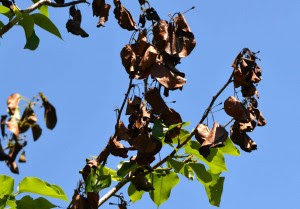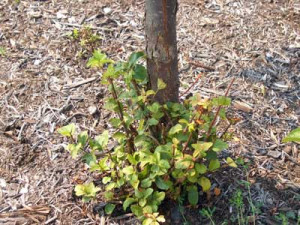Although the primary orchard pruning season in our climate is winter while trees are dormant, certain conditions may necessitate pruning any time of year. It is especially important to limit pruning after mid summer, but there are still some circumstances that require us to consider pruning:
-serious disease, fungus, or pest pressure
-dead or damaged wood, which may provide a future avenue for pests and disease
-root suckers, quick upright growth from the roots or base of the trunk
-weather causing a tree’s limbs to endanger a structure

If you’ve come up against the need for tree care that can’t wait until dormancy, here are some POP tips to remember:
1. Safety first!
a. Protect your free hand by wearing a glove.
b. Be extra careful if your saw gets caught up in wood because it can slash across your hand if suddenly freed.
c. If pruning something overhead, be aware that it may not fall as you expect.
d. Do not overreach, especially if using a ladder. We recommend a pole pruner.
e. Do not use power tools unless professionally trained. They’re more dangerous to you and the tree.
f. Be very careful if you’re near powerlines.
2. Sterilize, sterilize, sterilize! Especially when dealing with a bacterial or viral disease, and especially when a tree is in its active growth period, keep isopropyl alcohol or a bleach solution (1 part bleach: 10 parts water) on hand. Our preferred method is applying alcohol to pruning blades and saws with a spray bottle, but wiping with a saturated cloth also works. Sterilize your tools before you start, after every cut, and when you’re finished. Make sure to keep your hands clean, too. If you touch diseased wood and then touch the healthy tree, you can spread the disease.
3. Keep all pruning tools rust-free and as sharp as possible! If they are dull, they will not cut cleanly and will leave a tree more susceptible to disease.
4. Always use the smallest tool for the job at hand. Use hand pruners instead of a hand saw or bow saw, until and unless you can’t make the cut. Pruners are generally effective for branches up to 3/4″ in diameter.
5. When pruning a branch, make sure to cut just outside the branch collar, the donut-like, raised section of growth out of which the branch is growing. If you cut inside the collar, it is harder for the tree to heal and leaves the trunk or branch beneath open to pests and disease.
6. When dealing with bacterial infections like fire blight, cut 12 inches beyond where the tree has been visibly affected. The bacteria moves into the wood beyond where it shows physical symptoms.
7. Avoid pruning during a periods of extended drought.
8. Too much pruning, especially in the active season, can result in unhealthy growth. Pruning after mid summer can also result in new growth that doesn’t have time to harden off before winter, so avoid all but vital emergency pruning between August and December.
If you’re scared about pruning or not sure whether there are other methods of last resort, we are here to help. For more info, see POP’s full pruning guide for fruit trees, berry bushes, and fruiting vines.

MORE INFO:
http://www.plantamnesty.org/pruning-literature
Lee Reich, The Pruning Book and Grow Fruit Naturally
Carla Emery, The Encyclopedia of Country Living
Michael Phillips, The Holistic Orchard
This edition of POP TIPS prepared by Education & Outreach Director Robyn Mello.
SUPPORT US! If you found this entry useful, informative, or inspiring, please consider a donation of any size to help POP in planting and supporting community orchards in Philadelphia: phillyorchards.org/donate.